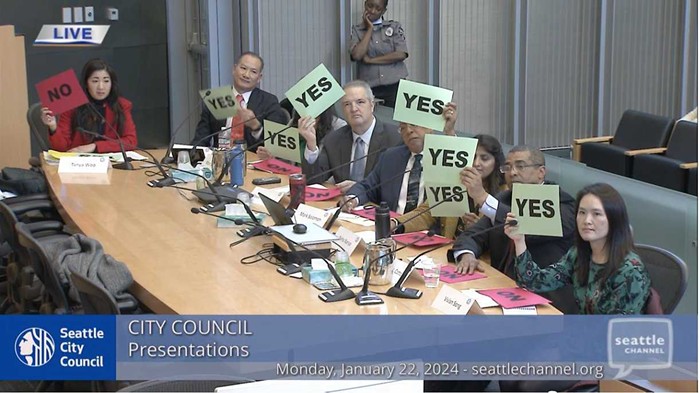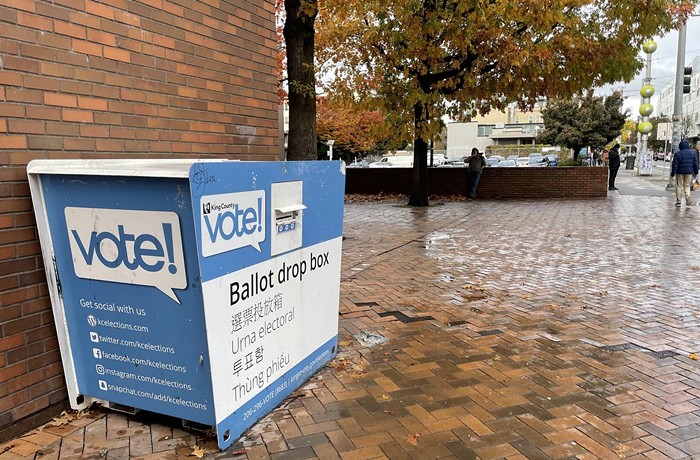Puget Sound is kind of fucked. Among its many problems: Fish in Hood Canal aren't getting the oxygen they need, invasive sea squirts (tube-shaped invertebrates) are crowding out important shell fisheries, and a food chain messed up by pollution and shoreline development means animals are struggling to eat.
Which is why a light-sensitive plant called eelgrass is so important. Eelgrass is one of the few plants in Puget Sound with a life span long enough to really settle in and act as a sustainable source of shade, shelter, and nutrients for low-on-the-food-chain sea creatures. Then when it dies, it feeds bugs and crabs. Eelgrass is like nonstop life support, and protecting existing beds of it is crucial. A lot of it grows in Puget Sound's shallow northern bays, and the rest is scattered in nearshore zones just below steep bluffs like the Maury Island Aquatic Reserve, one of just four areas in Puget Sound specifically designated for protection because of the high number of endangered species that live and eat in the area.
In 1998, local mining company Glacier Northwest (a subsidiary of Japanese giant Taiheiyo Cement) first applied to turn a dilapidated dock into a high-tech dock directly below its gravel mine on Maury Island, setting off a 10-year run of environmental-impact studies by government agencies, permit applications and mitigation plans by Glacier, and lawsuits from local environmentalists. Meanwhile, between 1998 and 2008, local environmental groups and the Washington State Department of Natural Resources (DNR) were learning more and more about the types of environmental parameters that sustain eelgrass habitat.
The proposed Glacier dock—shaped like a T and designed to transfer gravel to boats in a large conveyor tube—would significantly alter the sensitive nearshore habitat with construction noise, interrupted sediment drifting patterns along the beach, and ground contamination from the unloading process. But most importantly, the shade cast by the physical structure of the dock and conveyor tube would surely kill off the eelgrass. Doing so would be in violation of the Endangered Species Act (ESA) because of the way it would hurt chinook salmon, orcas, and other species that develop and feed in those eelgrass beds.
But a study done by the Army Corps of Engineers and completed in the summer of 2008 gave the project its final permit in the face of disagreement from environmental interests, and Glacier got permission to build the dock anyway. The permission came on December 2, 2008, when outgoing public lands commissioner Doug Sutherland—clearly stung after a narrow loss to Democrat Peter Goldmark in last year's election—granted Glacier, who had contributed $50,000 toward his reelection bid, a 30-year lease to work in the protected Maury Island reserve in one of his final moves before leaving office. ("I looked at the data we asked for, I looked at the information that was provided, and it appeared to me there was no scientific reason not to proceed," Sutherland told the Seattle Post-Intelligencer. As for the $50,000, he said, "I know nothing about the independent expenditure... That was not part of my campaign.")
So a number of environmental groups led by a Maury Island operation called Preserve Our Islands submitted a lawsuit in federal court seeking to halt construction on the dock. They had the support of the Goldmark administration, which doubted the legitimacy of Sutherland's decision to grant the lease (which Glacier only pays $1,500 a year for) because they said that new science provided compelling reasons to doubt the Army Corps of Engineers permit. To their great relief, U.S. District Court Judge Ricardo Martinez ruled on August 13 in favor of the salmon and the orcas, saying the Corps' permit was no longer valid. Without valid environmental permits, leases in aquatic reserves lose their standing.
"The ESA is a really blunt tool when it comes to protecting salmon and orcas," Mike Sato, communications director for fellow plaintiff People for Puget Sound, told The Stranger. "But it is a tool that can stop some really bad stuff from happening. And in this case, I think it did."
But it isn't a done deal. There is still a chance that two major federal agencies (the National Oceanic and Atmospheric Administration and the Corps) will find it worthwhile to reevaluate their permits based on the latest information. However, given the stress that our current economic situation has placed on many government agencies' discretionary spending, that is somewhat unlikely. Even if they do reevaluate the permit, the Corps could find that the project is too harmful to the chinook and the orcas. That would once again spell doom for the Glacier dock.
Bridget Moran, deputy supervisor for aquatics and agency resources with the DNR, describes this instance of halting the construction as a way to help mitigate against the "death by a thousand cuts" ailment that is slowly killing Puget Sound one habitat at a time. "Each one doesn't seem like it has a big impact," she said of the Maury Island issue. "This ruling tells us to look more broadly at the bigger pictures."
Puget Sound is still fucked—but a little less so today than it was a week ago. "We didn't move forward on protecting Puget Sound," Sato said. "But we sure didn't make it worse." ![]()


















